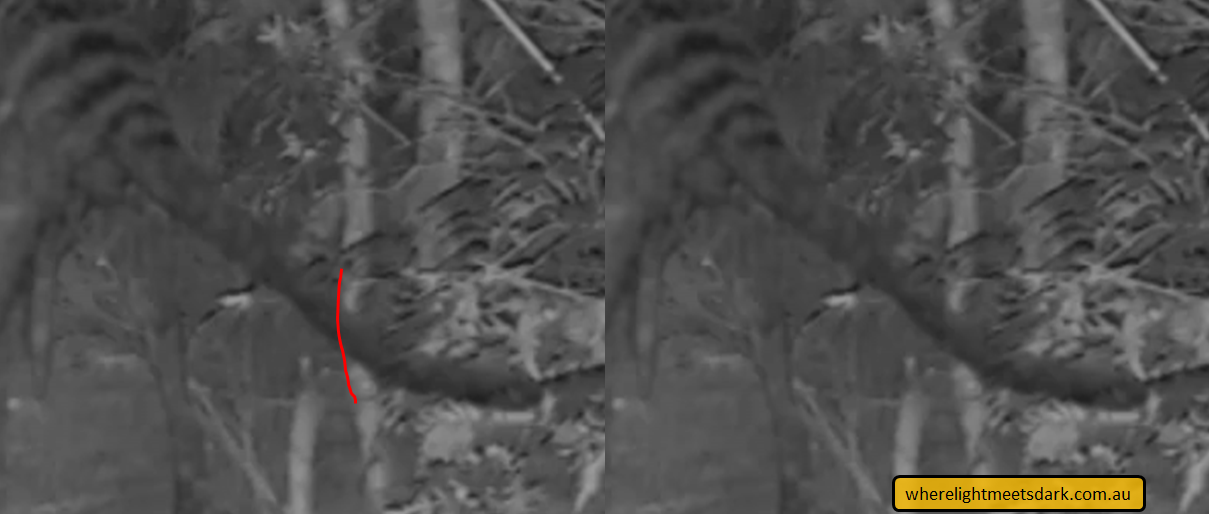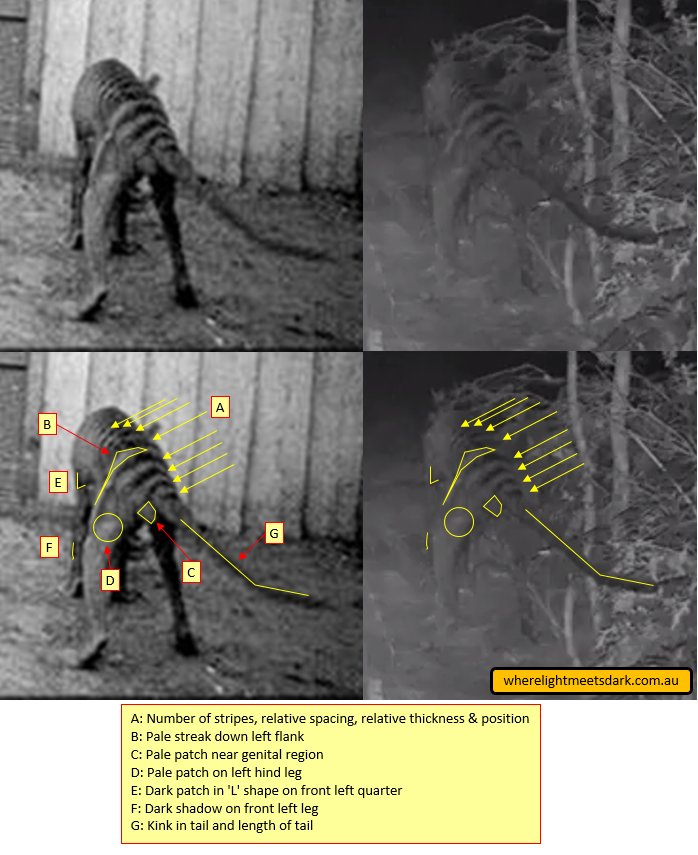Ellendale thylacine 2016 debunked
Overview
Late on 30 May 2017 a video appeared on YouTube purporting to show a camera trap photograph of a thylacine in the wild, photographed in 2016. The video contained audio of a digitally modified voice of a "farmer" who reportedly owned the property on which the photograph was taken. Together with static text messages displayed in the video it was explained that this thylacine was photographed near Ellendale, Tasmania.
Early on 31 May 2017 I published an article analysing this evidence for the Ellendale thylacine. In conclusion I posed 3 main points:
- The morphology of the animal in the photo makes it almost certainly a thylacine
- If a film production company wished to produce a video such as this, it could easily be done (and has been done for commercial film)
- But if we take the story presented at face value, it seems encouraging and warrants further consideration
Very soon after publishing this article (and sharing it on social media), Dean Alex - a reader on Facebook - located a historical photograph from 1911 depicting a thylacine that was nearly identical to that shown in the YouTube video. Many readers quickly concluded the video was a hoax. The article on WLMD was quickly updated to present the evidence.
Late on 31 May 2017, two further videos were published, again with text, but without audio. These purported to show a second photograph of the same thylacine. Readers on Facebook generally felt the publisher had lost credibility but they also could not readily match the thylacine in the new image to any known historical image.
Finally, on 1 June 2017 the Youtube channel was closed, associated account deactivated and videos removed.
Evidence of hoax
Transparency of animal
During the initial analysis I made the comment that there appears to be a transparency in the tail of the animal. In retrospect this appears to be evidence of digital manipulation although at the time I offered the benefit of the doubt by suggesting this may be a possible artefact of the low resolution and long shutter speeds of camera traps.
Similarity to historical photograph
On more detailed inspection, a significant number of morphological, positional and lighting details appears consistent between the 1911 Tucker photograph and the YouTube video. These are illustrated below.
Items of note are called out as follows:
| Item | Details |
|---|---|
| A | Number of stripes, relative spacing, relative thickness & position - these are essentially identical. The yellow arrows highlight individual stripes and were added to the YouTube image. Following this, an exact copy of the arrows was created (retaining relative positions and distances from each other) and overlaid on the Tucker photograph at left. Note that scaling the Tucker image up to the size of the YouTube image was not done with any accuracy, yet the stripe pattern is a near identical match. |
| B | Pale streak down left flank - even though there is less contrast in the YouTube image, this pale streak remains visible in both images. |
| C | Pale patch near genital region - this is near identical in shape between both images. |
| D | Pale patch on left hind leg - this is in the same position in both images. |
| E | Dark patch in 'L' shape on front left quarter - the angle of this 'L' shape, rotation and position is essentially identical between both images. |
| F | Dark shadow on front left leg - although small, this dark shadow is discernible and identically positioned between both images. |
| G | Kink in tail and length of tail - the angle, location and rotation of the kink in the tail is essentially identical in both images; likewise the tail length. |
Not listed above are, obviously, the shape and posture of the left hind leg, shape and posture of the right hind leg, orientation of animal and overall outline of the back.
Some discernible differences are:
- The right hind foot in the YouTube image appears trimmed down.
- Likewise the right front foot appears trimmed to a stub.
- The bold shadow under the left hind foot is not evident in the YouTube image.
- The dark tone of the front right leg appears lightened to match the hind left leg in the YouTube image.
Facebook reader Alex Evans produced a video transitioning between the Ellendale thylacine and Tucker's 1911 photograph.
Lessons learned
Criteria for proving the persistence of the thylacine
As noted in the original article, if a film production company wanted to produce a video such as that of the Ellendale thylacine, they could almost certainly do so. This in no way implies the Ellendale thylacine is a film production company's viral marketing attempt or similar. Rather, this underscores the sentiment proposed in Robert Paddle's book "The Last Tasmanian Tiger" -
- "... the critereon for establishing the existence of the thylacine beyond 1936 can only be met through the production of a body, either dead, or, preferably alive"
Whether high quality photographic or video evidence may be accepted in the company of the claimant's reputability and, preferably, consistently documented efforts over time, remains to be seen if and when such a situation eventuates.
Questions to ask when considering evidence for the thylacine
Additional considerations to be made in the case of the Ellendale thylacine include the following:
| Question | Answer in favour of authenticity | Answer in favour of hoax evidence |
|---|---|---|
| Why was the voice-over digitally modified? | In order to preserve the anonymity of the claimant. (Thylacine sighting claims have, in the past, triggered massive influxes of tourists to a region). | To preseve the hoax. |
| Why was the video publisher motivated to share the image? | Part of the back story was that negotiations were in place to have the alleged camera trap video included in a documentary. One might reason that publicity prior to this may increase financial or other reward, once the documentary is produced. On the other hand, if the footage is authentic there should almost certainly be no difficulty in raising publicity prior to screening a documentary. | To perpetuate a hoax - for reasons perhaps only speculative. |
| Was the publisher of the video also the creator of the video? | At various points the publisher described the video creator as someone else - the farmer, or more specifically, his son. This introduces the question of why the video owner consented to a third party - seemingly unrelated to the legal counsel or documentary production company - to publish photos. | The publisher could be one and the same person who created the hoax video. Alternatively, more than one person could have worked together to produce the hoax. |
Categories of evidence to consider when evaluating alleged evidence of the thylacine
From the point of view of analysing purported evidence of the thylacine, the above considerations break down into a few broad categories:
- Properties of the evidence itself - Evidence for or against authenticity, within the photographic or video evidence itself. For example, the transparency of the animal suggests the image may be a digital manipulation and not authentic.
- Similarity with historical documentation - For example, being near-identical to Tucker's photograph suggests the image is not authentic.
- Credibility of the back story - For example some factors (location, claimed history of sightings) seemed credible while others did not (no clear motive for genuine evidence to be published ahead of a documentary production).
- Identity and credibility of the claimant - For example, the claimant pursued anonymity, which may actually not detract from authenticity, but the credibility of the claimant could not be evaluated from anything beyond the evidence presented and its manner of presentation.
Crowd sourcing the analysis effort
The reality is that claims such as this one, published on social media, attract significant numbers of interested parties. Many of the people evaluating the evidence are experts in biological sciences, or experts on the thylacine in particular. In the case of the Ellendale thylacine, the evidence was made public by the publisher of the video. This automatically opened up the opportunity for a crowd-sourced effort at establishing the authenticity of the evidence. Tucker's photograph was identified very quickly as a potential match.
While crowd sourcing provided a very swift result in this case, there is also an argument to be made for keeping evidence confidential, and that is in the conservation interests of the species. In such a scenario the audience may be limited to career experts on the thylacine and those with the capacity for making conservation decisions.
Further evidence of hoax
Although two further videos were published, the similarity of the first photo to Tucker's photo reduced the credibility of the publisher - or at least the alleged camera trap operator - to the point that serious examination of subsequent videos was not merited.
Finally, it seems the YouTube publisher themselves was aware that the Ellendale thylacine photo was a hoax, as demonstrated below.
This begs the questions - why specify this picture is for use with the "Thyla Hoax Channel"? Is this to distinguish it from some other channel the publisher operates?


